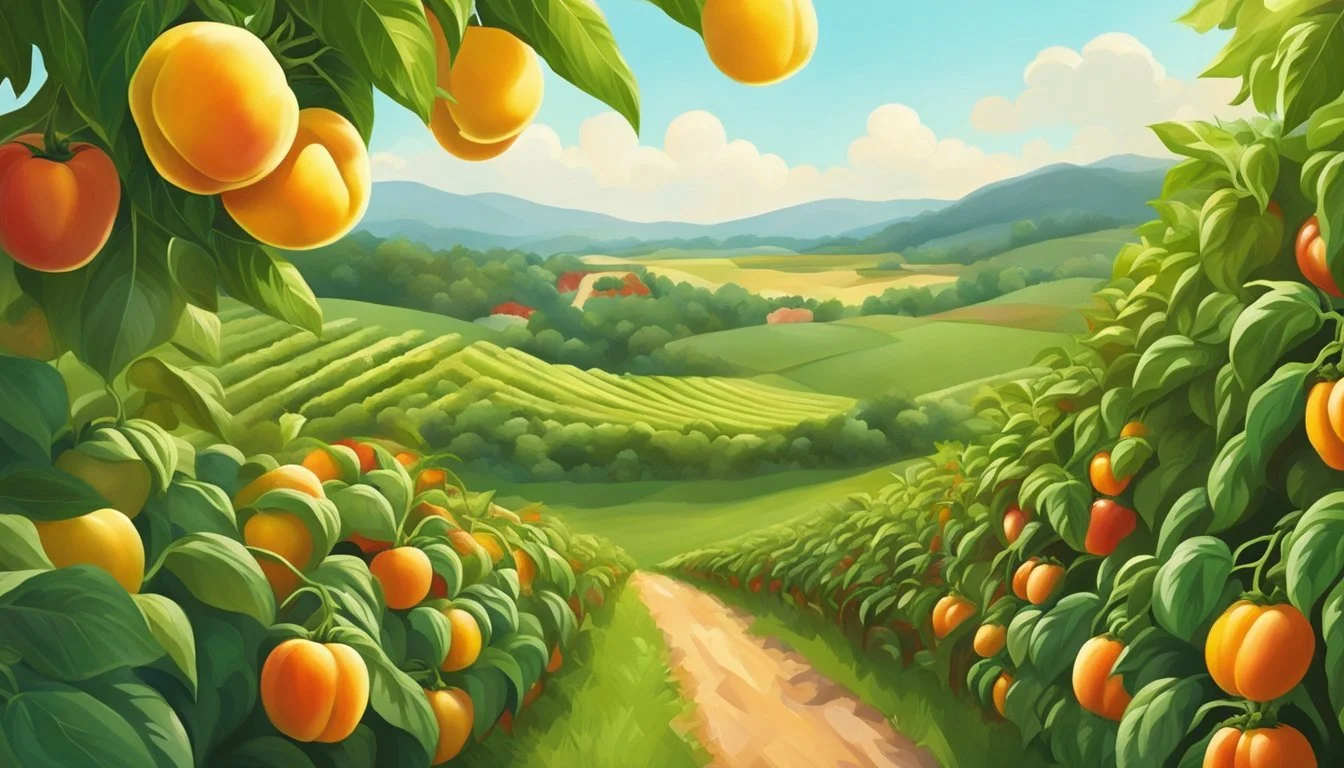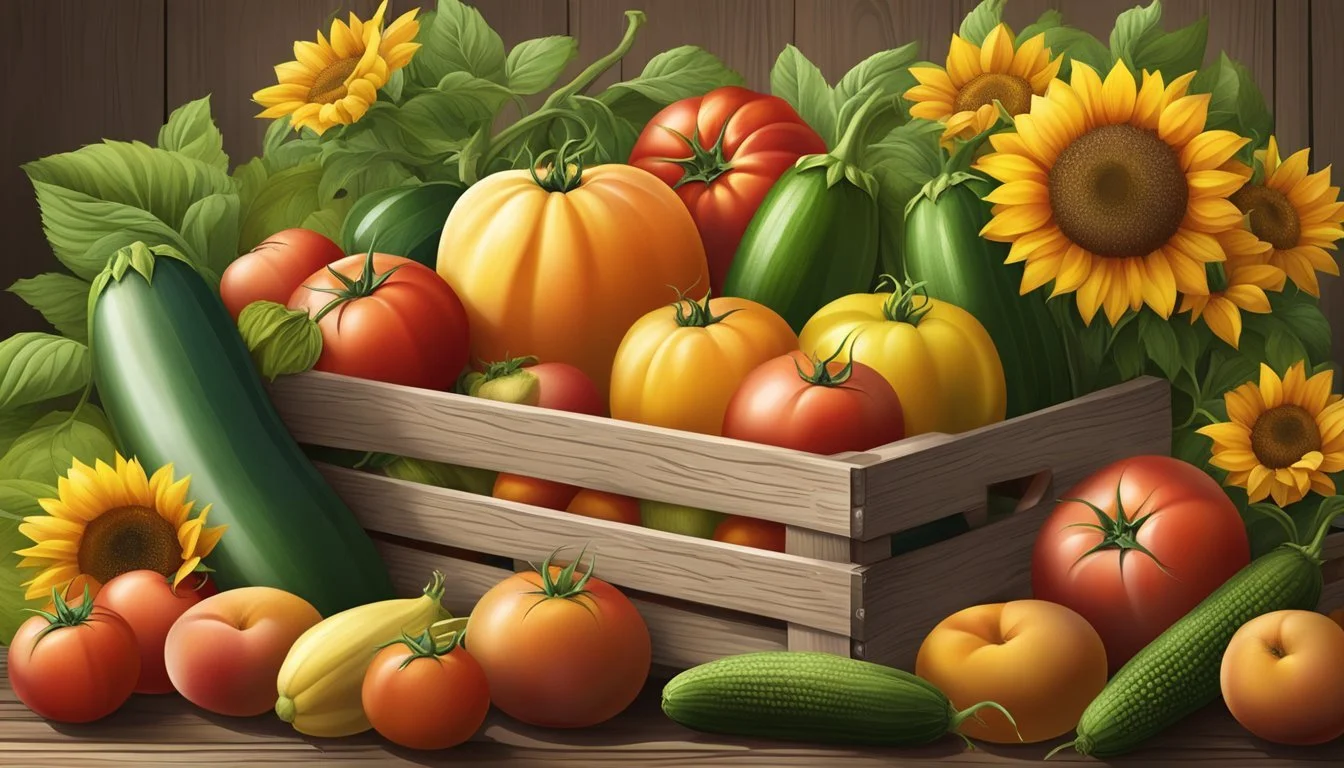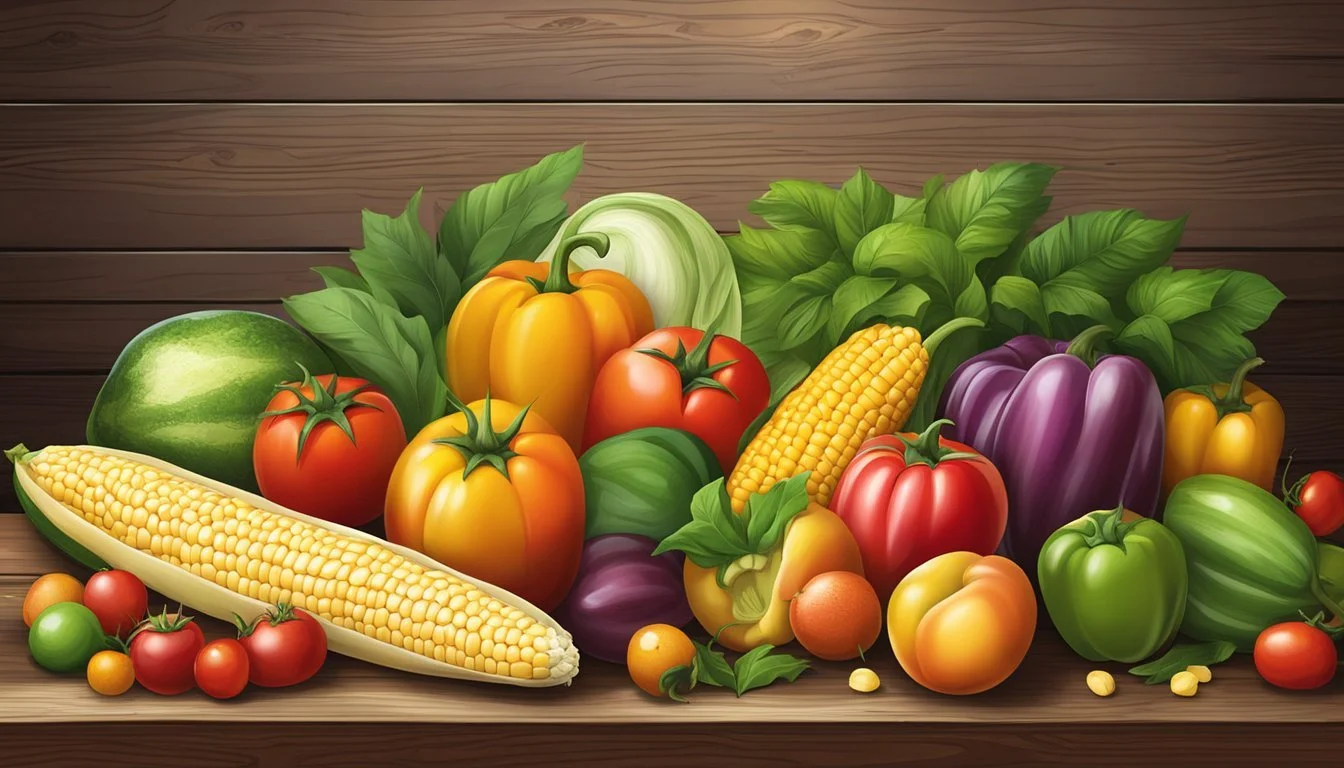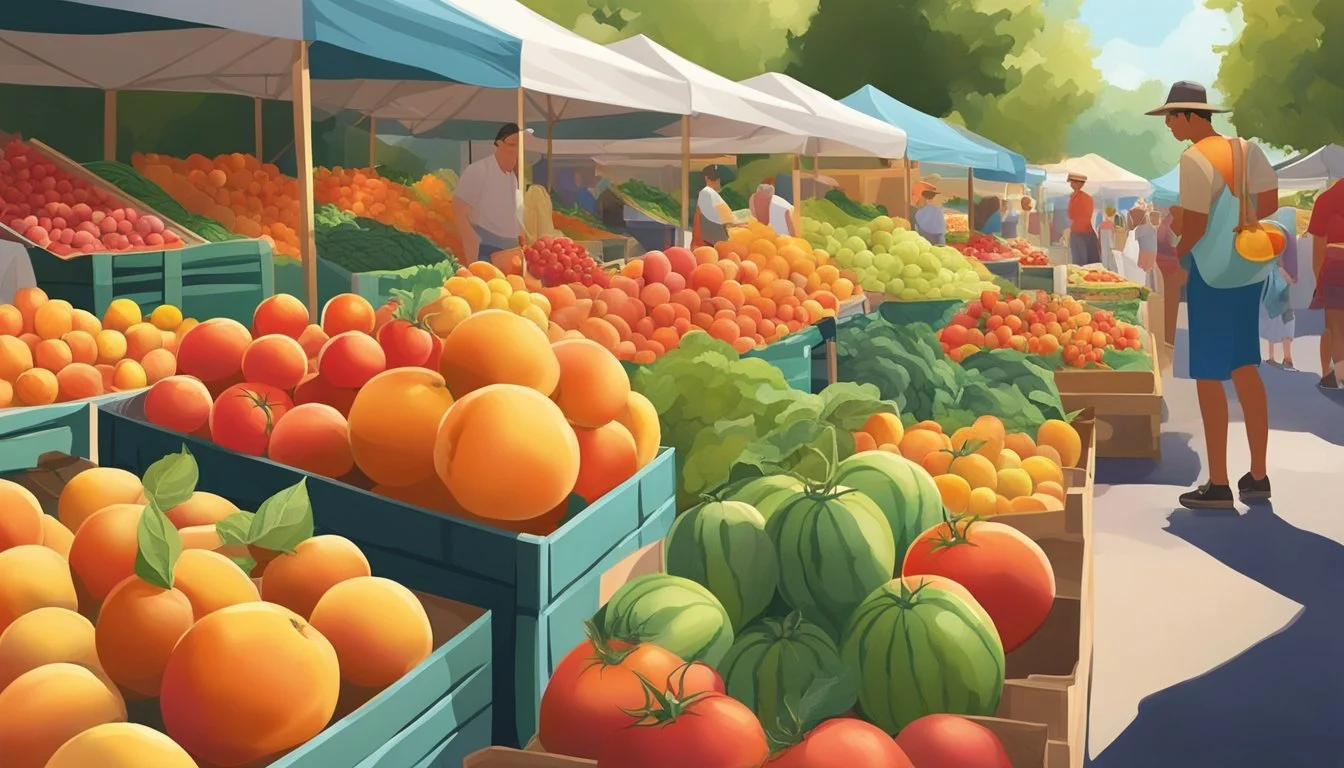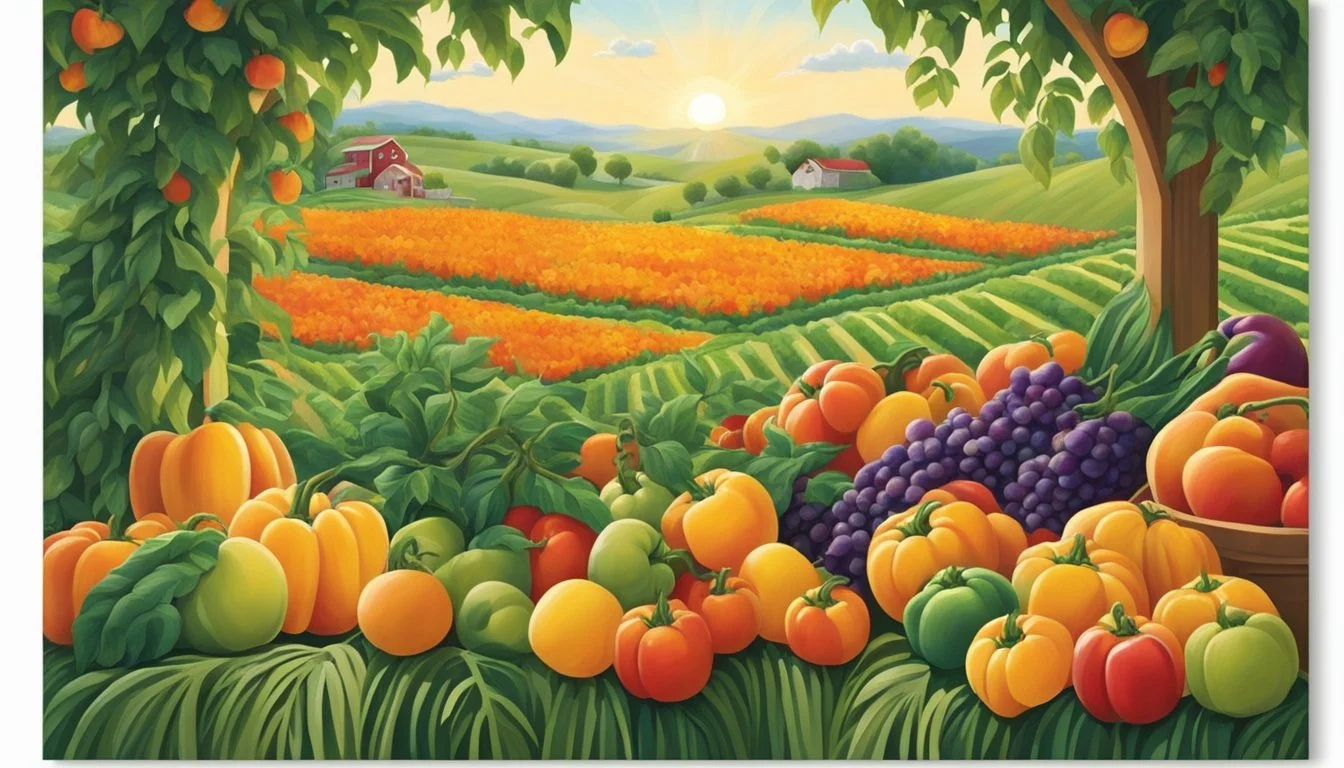Virginia Seasonal Fruit & Vegetables in August
Your Monthly Guide to Fresh Produce
This Article is Part of our Virginia Seasonal Fruit & Veg Calendar
August in Virginia heralds a bountiful season for fruit and vegetable enthusiasts. John Doe, a seasoned Virginia farmer, affirms that the warmer climate of this month allows a variety of produce to thrive. Markets brim with fresh options, ranging from the zesty tang of tomatoes (What wine goes well with tomatoes?) to the sweetness of peaches. These summer offerings not only provide a feast for the palate but also epitomize the peak of nutritional value, ensuring that consumers get the best of what the season has to offer.
Local gardeners and commercial growers alike often note that the diversity of Virginia's August harvest can support a whole spectrum of culinary exploration. Chiles add a kick to salsas and preserves, while cucumbers (how long do cucumbers last?) offer a refreshing crunch in salads (What wine goes well with salads?) . Sweet corn and juicy watermelons are ubiquitous at picnics and barbecues, becoming staples of the American summer diet. This month is particularly special for the state's agriculture, as it showcases the full splendor of Virginia's fertile lands and the hard work of its farmers.
Incorporating seasonal fruits and vegetables into daily meals is a practice recommended by dieticians for its health benefits. Shoppers are encouraged to visit their local farmers' markets to experience the fresh, high-quality produce available. Doing so not only supports Virginia's agricultural economy but also promotes a sustainable lifestyle by reducing the carbon footprint associated with long-distance food transportation.
Understanding Seasonality
When discussing the produce of Virginia in August, it is pivotal to grasp the concepts of seasonal eating. Knowing when fruits and vegetables are at peak availability can enhance both the nutrition and flavor of meals.
Seasonal Eating Basics
In August, Virginia's seasonal palette includes a range of fruits and vegetables that are at the peak of their harvest. Summer produce is bountiful and includes tomatoes, peaches, melons, and corn, among others. A precise August Produce Guide reveals that these items are not just fresh but also in their prime, offering optimal taste and nutritional benefits during this month. The notion of eating seasonally entails selecting and consuming produce around the time it naturally ripens and is harvested.
Benefits of Seasonal Produce
Consuming produce when it's in season provides multiple advantages. Firstly, seasonally fresh produce generally packs a more powerful flavor punch. For example, biting into a ripe, juicy peach in August is far superior taste-wise to eating one that's been shipped halfway around the globe in the off-season. Secondly, fruits and vegetables harvested within their appropriate season have been shown to contain more nutrients than those picked before or after their peak. Seasonal consumption also aligns with environmental sustainability, often requiring less transportation and resources than produce that is not in season. Additionally, it supports the local economy, as consumers buying seasonal items are more likely to be purchasing goods grown by local farmers.
Fruit Highlights of August
August in Virginia showcases a bounty of fruits, marked by the sweet and juicy flavors that peak during the late summer months. Enthusiasts relish the ripe stone fruits and berries, as well as the refreshing variety of melons that become available.
Stone Fruits and Berries
Peaches stand out with their delicate aroma and lush softness, reaching their apex of flavor. They are often enjoyed fresh, or can be baked into desserts. Nectarines, with a slightly firmer texture, offer a more intense sweetness ideal for snacking or grilling. Plums, with their sweet and tangy taste, round out the stone fruit selection, perfect for jellies or eating fresh.
Berries are also abundant. Blackberries and blueberries are at their prime, with deep, rich flavors that excite the palate whether consumed alone or in pastries. Raspberries, with their distinctive sweet yet slightly tart profile, are another local favorite, often found fresh in farmers' markets throughout Virginia.
Refreshing Melons
August brings the peak season for a variety of melons, offering a refreshing reprieve from summer heat. Watermelon, with its crisp and hydrating flesh, is a classic favorite, while the succulent and sweet cantaloupe (how long does cantaloupe last?) graces many a summer fruit dish. These melons, cherished for their juicy and sweet characteristics, are commonplace in Virginia's local markets and are often a centerpiece at summer gatherings.
August's Vegetable Bounty
In August, Virginia's gardens are flush with an array of vegetables ripe for the picking. The warm weather brings peak harvests for many of the state's favorite produce, particularly the family of cucurbits, the prolific nightshade varieties, and the versatile legumes and pods.
Crucial Cucurbits
Cucumbers: They thrive in Virginia's August heat, offering a fresh crunch perfect for salads or pickling.
Types of cucumbers available:
Slicing cucumbers
Pickling cucumbers
Summer Squash & Zucchini: These relatives are also abundant, with tender flesh that's ideal for grilling or sautéing.
Common varieties found:
Yellow summer squash
Green zucchini
Nightshade Nuances
Tomatoes and Peppers: August in Virginia sees a surge in nightshade produce such as tomatoes and peppers. The sun-loving tomatoes arrive in an assortment from beefy slicers to sweet cherries (how long do cherries last?).
Tomato types to look for:
Heirloom
Cherry
Roma
Eggplant (What wine goes well with eggplant?): Eggplants (What wine goes well with eggplant?) reach their glossy peak, with their meaty texture making them perfect for hearty dishes.
Eggplant varieties for August:
Globe
Japanese
Legumes and Pods
Beans: A staple in Virginia gardens, beans come into their own, with varieties such as green beans and shelling beans being particularly plentiful.
Bean types in season:
Green beans
Wax beans
Shelling beans
Peas: While starting to dwindle, some pea varieties can still be harvested in early August, adding a sweet pop to meals.
Available pea types:
Sugar snap peas
Snow peas
Herbs and Greens
August in Virginia offers a rich bounty of herbs and greens, providing an array of flavors and nutritional benefits. The region's warm days and cool nights create optimal conditions for a variety of leafy vegetables and aromatic herbs to thrive.
Leafy Salads and Accompaniments
In August, salad enthusiasts can indulge in an abundance of leafy greens. Varieties such as kale, spinach, and arugula are in peak season, boasting full flavors and crisp textures. These greens serve as the cornerstone for nutritious salads and are also perfect for sautéing or adding to smoothies. Virginia's lettuce varieties, including Romaine and Butterhead, remain tender and are ideal for both simple and elaborate salad preparations.
Kale: Rich in vitamins and minerals, with a sturdy texture
Spinach: Tender and nutrient-dense, versatile for many dishes
Arugula: Peppery flavor, excellent in salads or as a pizza topping
Lettuce: Various types offer crunch and moisture to salads
Flavorful Herbs
The state's gardens are also teeming with herbs like cilantro, basil, mint, parsley, sage, and thyme. These herbs add essential flavors to many dishes, whether they're used fresh or dried.
Basil: A staple in Italian cuisine, with a sweet and slightly peppery taste
Cilantro: Common in Mexican and Asian cuisines, known for its bright and citrusy notes
Mint: Offers a cool and refreshing flavor, ideal for drinks and desserts
Parsley: Often used as a garnish, it has a mild and clean taste
Sage: Earthy and aromatic, a favorite in poultry dishes
Thyme: Delicate and slightly minty, pairs well with meats, stews, and soups
Each herb not only contributes a unique layer of flavor but also provides various health benefits, such as aiding digestion and offering anti-inflammatory properties. These herbs are extensively used across cuisines and are an essential part of the culinary landscape in Virginia during August.
Roots, Bulbs, and More
August in Virginia is an excellent time for a bounty of root vegetables and bulbous plants. These nutritious and versatile staples form a significant part of the local culinary palette.
Underground Delights
The soil of Virginia yields a rich harvest of carrots and beets, known for their vibrant colors and sweet flavor profiles. These underground gems store energy in their roots, offering consumers a wealth of nutrients. Carrots are often found in a range of colors from the traditional orange to purple, red, and even white. They add crunch and sweetness to any dish, whether grated raw in salads or roasted to deepen their flavor.
Radishes, with their peppery taste, are perfect for adding a fresh, crisp element to salads. Onions and garlic, the foundations of countless recipes, provide deep, aromatic undertones when cooked, and can also be enjoyed raw for a more pungent bite.
Sweet potatoes and potatoes showcase their versatility in the kitchen, being well-suited to baking, mashing, or frying. Their earthy flavors (What wine goes well with earthy flavors?) become the comforting cornerstone of any meal, from summer barbecues to homely dinners.
Late Summer Arrivals
As late summer sets in, certain root vegetables reach their peak. Sweet potatoes, with their creamy texture and sweet-spicy flavor, are just beginning to be harvested. They contain a wealth of vitamins A and C and can be prepared in innumerable ways, from sweet potato fries to pies.
The humbler turnips and parsnips should not be overlooked, as they provide a slightly sweet, earthy flavor to dishes. When roasted, they develop a beautifully caramelized exterior with a tender, flavorful interior. Potatoes, a staple in many kitchens, thrive in the season, ready to be turned into salads, gratins, or simply roasted with a sprinkle of rosemary.
Finally, the appearance of pumpkins heralds the transition from summer to fall. While commonly associated with autumn, pumpkins start becoming available in late August. They're not just for decoration; their flesh is perfect for soups, pies, and roasting, offering a subtle sweetness and creamy texture.
Through both traditional and innovative uses, these root vegetables and bulbs provide a tapestry of flavors that are as nutritious as they are delicious, embracing the full circle of seasonal eating in Virginia.
Culinary Ideas for Seasonal Produce
In August, Virginia's bounty offers a plethora of options for fresh and inventive culinary creations. With an array of vibrant tastes and textures at their disposal, chefs and home cooks alike can take full advantage of seasonal produce to elevate their dishes.
Refreshing Salads and Smoothies
Salads: August brings crisp greens like chard and a variety of herbs, perfect for constructing vibrant salads. Incorporate sweet, juicy cantaloupes for a refreshing twist or add roasted beets for an earthy flavor.
Example: A chard-based salad tossed with diced cantaloupe, crumbled feta, and a light citrus vinaigrette.
Smoothies: The smooth texture of pureed seasonal fruits such as cherries and peaches creates rich and nutritious smoothies.
Example: A smoothie blending peaches, cherries, and a touch of cilantro for a refreshing summer beverage.
Grill and Roast
Grill: Vegetables like eggplants are superb when grilled, developing a smoky flavor that's excellent for various dishes, from salads to the main course.
Example: Grilled eggplant (What wine goes well with grilled eggplant?) slices layered in a delectable eggplant parmesan (What wine goes well with eggplant parmesan?).
Roast: Roasting intensifies the natural sweetness and flavor of many vegetables. Bell peppers and root vegetables, easily found in August, are perfect for roasting.
Example: Roasted carrots and celeriac blended into a smooth sauce for pasta or as a base for soups.
Sweet, Savory, and Sauces
Desserts: Take advantage of stone fruits like cherries in clafoutis or peach cobblers. Their natural sweetness is perfect for desserts and requires minimal additional sugar.
Example: A cherry clafoutis with a dusting of powdered sugar as a simple yet elegant dessert.
Sauces: Fresh tomatoes and basil are in season, making it an ideal time to prepare homemade tomato sauces, which can be used in a variety of dishes.
Example: A savory tomato-basil sauce, perfect for enhancing pasta or as a base for pizza.
By exploring these ideas, anyone can make the most of August's fresh produce in Virginia, creating dishes that are as nutritious as they are flavorful.
Choosing the Best Produce
When selecting August's freshest fruits and vegetables in Virginia, knowing how to identify ripeness and proper storage methods ensures peak flavor and longevity of produce.
Identifying Ripeness
Tomatoes should have a rich color and slight firmness, yielding to gentle pressure. They should feel heavier than they look, indicating juiciness. Cantaloupes emit a sweet fragrance at the stem end and possess a rind that yields slightly to pressure, a sign of ripeness. For peaches, look for a well-defined crease and a slight give. A peach's scent should be subtly sweet, indicating it's ripe and ready to eat. Green beans should be firm and snappy, while corn should have bright green husks and plump kernels that burst when pinched.
Storage and Preservation
Store ripe tomatoes on the countertop away from direct sunlight to keep them firm and preserve taste. Cantaloupes can be kept at room temperature until ripe, then refrigerated to maintain softness. Peaches should be stored at room temperature until they reach desired softness, then refrigerated to slow further ripening. Green beans thrive in a plastic bag in the refrigerator's crisper, remaining crisp and fresh.
To keep corn at its peak, refrigerate with husks on. The chill maintains the kernels' firmness and sweetness, but corn should be consumed quickly as it loses its sugar content rapidly after harvest.
Local Farming and Markets
August marks a time of abundance in Virginia, with local farms and gardens yielding a rich variety of produce. This seasonal surge is most visible in the numerous farmers' markets and produce stands dotting the Commonwealth.
Supporting Virginia Farmers
Buying seasonal produce directly from local Virginia farms is an excellent way to support regional agriculture. Farms in Virginia benefit from this exchange as it bolsters the local economy and maintains the farming community. When consumers purchase fruits and vegetables directly from these farms, it ensures that a larger share of the revenue returns to the growers.
Advantages for Farmers:
Better profit margins
Stronger connections with consumers
Increased local economic impact
Farmers' Markets and Produce Stands
Visiting farmers' markets and produce stands provides consumers with the freshest possible produce while contributing directly to the success of local growers. In August, these markets are replete with seasonal offerings such as tomatoes, sweet corn, peaches, peppers, and more. Each market showcases the bounty of Virginia's gardens, often including organic and heirloom varieties becoming part of Virginia's burgeoning farm-to-table movement.
Market Offerings may include:
Tomatoes: Various sizes and heirloom types
Sweet Corn: Picked at peak sweetness
Peaches: Juicy and ripe, perfect for eating fresh or canning
Peppers: Ranging from sweet to hot varieties
Green Beans: Crisp and perfect for side dishes or preserving
Not only do these markets offer an array of fresh produce, but the opportunity for consumers to learn about the source of their food, asking questions, and seeing firsthand the seasonal cycles of Virginia's agricultural landscape.
Seasonal Eating Beyond August
As August wanes, Virginia's seasonal eaters can look forward to a rich array of fruits and vegetables that bloom into the ensuing seasons. This period requires preparation for the transitioning weather and an anticipation for September's bountiful harvest.
Preparing for Transitioning Seasons
Transitioning from the warm summer months into the crisp ambiance of fall, Virginians should ready their pantries and recipes for a shift in available produce. September welcomes a variety of fruits that not only signal the change of seasons but also offer freshness and flavor integral to autumnal dishes.
Apples: A quintessential fall fruit, apples start coming into season, which can range from tart varieties like Granny Smith, ideal for pies, to sweeter options like Gala, perfect for eating fresh.
Grapes: Virginia vineyards burst with grapes that are ripe for the picking and not just for wine. Table grapes become plentiful, providing a sweet snack or a natural burst of flavor in salads and cheese platters.
Figs: With a short second season in early fall, figs offer their unique sweetness. They can be enjoyed fresh, turned into jams, or used as a decadent addition to desserts and savory dishes alike.
As the months progress, more fall favorites will join these early starters, turning Virginia's tables into a display of the season's finest.
Anticipating September's Harvest
Come September, the cooler air preserves the sweetness in fruits and provides the right conditions for several varieties of pears and more to reach their peak.
Pears: As summer fruit like berries begin to wane, pears come to the forefront, offering a smooth transition with their soft, buttery texture and sweet taste. Varieties like Bartlett and Bosc can be found in abundance.
The harvest doesn't stop at fruits; the season's generosity extends to vegetables. Leafy greens revive in the cooler temperatures, bringing a new life to salads and side dishes. Root vegetables like carrots and beets, which are available year-round, can be enjoyed with renewed appreciation as their earthy flavors complement the hearty meals of fall.
While August may mark the end of summer's peak, the subsequent months in Virginia are filled with their own treasure trove of seasonal eating opportunities, each with the potential to inspire and nourish through the cooler days.


